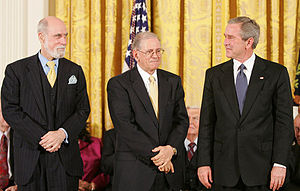
- Image via Wikipedia
A mid-life crisis threatens its future
THIS past week marked the 40th birthday of the internet. And, like most other things on the brink of middle-age, the internet is struggling with its own mid-life crisis. At issue is whether it can continue to provide equal access for everyone and everything, or must evolve into something entirely different in order to cope with changing circumstances.
Such contentious issues never dawned on the dozen or so engineers who gathered in the laboratory of Leonard Kleinrock (pictured below) at the University of California, Los Angeles (UCLA) on September 2nd, 1969, to watch two computers transmit data from one to the other through a 15-foot cable. The success heralded the start of ARPANET, a telecommunications network designed to link researchers around America who were working on projects for the Pentagon. ARPANET, conceived and paid for by the defence department’s Advanced Research Projects Agency (nowadays called DARPA), was unquestionably the most important of the pioneering “packet-switched” networks that were to give birth eventually to the internet.
Packet switching slices messages (whether text, graphics, audio or video) into suitably sized blocks of data, like a series of letters in the mail. Each “letter” has an address on the front, a sequence code on the back, and a chunk of the data inside the envelope. The network over which the packets travel routes them independently of one another, allocating the path that each is to take according to the resources available at that instant.
The goal is to get the best use out of the limited capacity of the various links in the network. As a bonus, packet switching ensures that, thanks to the many different routes individual packets can take, the message will always get through—even if it has to wait for errant packets that have taken the long way round. Such redundancy makes packet networks—unlike traditional circuit-switched networks—extremely robust.
Several weeks after the demonstration at UCLA, the Stanford Research Institute in the Bay Area joined the fledgling packet-switched network, to be followed shortly thereafter by the University of California, Santa Barbara, and the University of Utah. By December 1969 the first four nodes of ARPANET were up and running.
One crucial thing was still missing before ARPANET could become the internet as it is known today. There was no way of connecting it to other packet-switched networks, especially those based on the X.25 standard developed (from ARPANET) by the International Telecommunication Union, and used widely in Europe and elsewhere.
The missing link was supplied by Robert Kahn of DARPA and Vinton Cerf at Stanford University in Palo Alto, California. Their solution for getting networks that used different ways of transmitting data to work together was simply to remove the software built into the network for checking whether packets had actually been transmitted—and give that responsibility to software running on the sending and receiving computers instead. With this approach to “internetworking” (hence the term “internet), networks of one sort or another all became simply pieces of wire for carrying data. To packets of data squirted into them, the various networks all looked and behaved the same.
Related articles by Zemanta
- Here Is the First Photo of the Internet [Image Cache] (gizmodo.com)
- The Internet Turns 40 (inquisitr.com)
- Happy Birthday, Internet! (tech.slashdot.org)
- TIMELINE: Internet Turns 40 Today… Or Does It? (abcnews.go.com)
- Will Google or Cisco Determine Our Future Broadband Networks? (gigaom.com)










